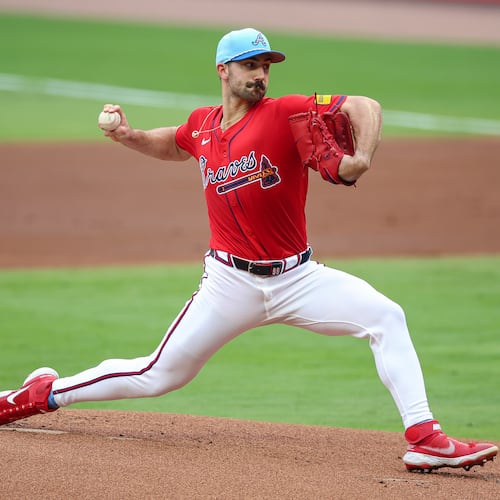Mike Kelly.
As the Braves finalize their options for the first two rounds of the MLB draft on Thursday night — the scouting department has been encamped in a Turner Field conference room since Sunday — the franchise anticipates a formidable haul. Not only do they possess the No. 3 overall pick, the club's highest since 1991, but they will pick three more players on the first day and then a fifth with the third selection of the third round, which starts Friday.
That’s five of the first 80 picks. Only San Diego, with six picks in the top 85, will be busier.
But it is the No. 3 pick that stirs the local curiosity. The franchise’s long run of success has meant the Braves haven’t owned a top-5 pick in 25 years. Though this draft appears light in prototypical No. 1 prospects, the Braves will have their options, whether they settle on established college hitters — Mercer outfielder Kyle Lewis, Tennessee third baseman Nick Senzel, Louisville outfielder Corey Ray — or high schoolers — New Jersey left-hander Jason Groome, Californian outfielder Mickey Moniak, Kansas right-hander Riley Pint.
“It’s a pitching-heavy draft, but we’ll have an opportunity at pick 3 to get a really good player,” Braves general manager John Coppollela said. “That could be a pitcher or a hitter, high school or college. We like the talent at the top of the draft, and we feel very confident we’re going to get a player we really like a lot.”
The No. 3 pick has it history. Matt Williams was a No. 3 (1986), as were Paul Molitor (1977) and Robin Yount (1973). Kansas City chose first baseman Eric Hosmer No. 3 in 2008 and last fall, he broke George Brett’s franchise postseason RBIs record. Tampa Bay used its No. 3 pick in 2006 on Evan Longoria, who helped turn a losing operation into a contender.
But a No. 3 also was used in 2009 by San Diego to take Cartersville outfielder Donovan Tate, who through injuries and substance-abuse problems never rose above Single-A. Third baseman Josh Vitters was the Cubs’ No. 3 in 2007. He eventually appeared in 29 games in Chicago, washed out of the majors last year and is playing for the independent league Bridgeport (Conn.) Bluefish, hoping a scout sees something he likes.
“Teams still whiff. It is still sports,” said John Manuel, editor of Baseball America. “It’s the reason we watch. It’s still unpredictable.”
Which introduces Kelly, who in 1991 at Arizona State was the consensus top college outfielder in the country. Speedy with power — his 46 homers for the Sun Devils exceeded Barry Bonds — he came to Atlanta as a No. 2 pick, the first draftee under new GM John Schuerholz.
His production in the minors was spotty. Four years in, he was being out-hit by Mike Mordecai and journeyman Luis Lopez at Triple-A Richmond. He eventually appeared in only 127 Atlanta games between 1994-95 before he was dealt to Cincinnati for reliever Chad Fox. As a Brave, he recorded more strikeouts (66) than hits (47).
Back when early draft picks were just another rite of Atlanta summer, the club frequently guessed right, landing Dale Murphy (No. 5 in 1974), Bob Horner (No. 1 in 1978), Steve Avery (No. 3 in 1988) and Chipper Jones (No. 1 in 1990). The same organization drafted Ken Smith (No. 3 in 1976), Brad Komminsk (No. 4 in 1979) and Tyler Houston (No. 2 in 1989).
Which may explain Braves director of scouting Brian Bridges’ sleep patterns.
“There’s no time like right now,” Bridges said. “People lay in bed and sleep at night. I lay in bed and count popcorn on the ceiling, just thinking about things as we move forward with players.”
With 42 players to draft through Saturday, to be followed by the international signing period that opens July 2 — the Braves hold four of the top 93 signing slots — the club figures to strengthen a farm system already ranked the third-most talented in the game.
But a No. 3 pick provides a headline for an franchise that has staked its reputation on this massive rebuild. And as was the case back in 1991, they could use a big bat.
“It’s kind of funny that we have them picking an African-American, college outfielder, just like the last time they picked this high,” Manuel said. “It’s coincidental, but I do think they want at bat at 3. I think they want a bat who will cut a deal at 3. The consensus college top bats, Ray and Lewis, are not (Scott) Boras Corporation clients. Nick Senzel is. That’s why you hear the Braves so consistently tied to Ray and to Lewis.”
About the Author
Keep Reading
The Latest
Featured

